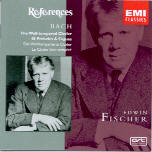Edwin Fischer’s pioneering 1930s recordings of the complete Bach Well-Tempered Clavier get a serious sonic facelift via new transfers effected by Andrew Walter. The results drastically improve upon Keith Hardwick’s nasal, constricted restorations issued in 1990 (EMI CHS7 63188-2); there’s more presence, room tone, and “air” between the notes. Above all, Fischer’s gorgeous sonority rings out with colorful majesty. Listeners accustomed to the dry-point, harpsichord-oriented aesthetic typifying piano versions of the “48” from Glenn Gould, Friedrich Gulda, and Rosalyn Tureck may find it hard relating to Fischer’s velvet paws in gothic gloves approach to Bach. True, Fischer unabashedly embraces the piano’s expressive potential to its fullest capacity; yet his timbral and dynamic choices stem from internal responses to each Prelude and Fugue’s structure and emotional character. The pianist is not averse to reinforcing bass lines with left-hand octaves, as he does throughout Book I’s B minor Prelude. Faster selections stand out for fleet, non-pedaled fingerwork that belies the old wives’ tale of Fischer having no technique. There are wrong notes, to be sure, but they have more to do with Fischer’s discomfort in the recording studio than faulty preparation.
A competing, more expensive edition from Pearl occupies two double-CD sets containing virtually all of Fischer’s solo Bach output. Seth Winner’s transfers from commercial shellac pressings reduce surface noise to a constant, unobtrusive layer of hiss. By contrast, Andrew Walter allows occasional surface blotches to stand as is, but has the advantage of better source material. The Preludes and Fugues are banded separately on Pearl, together on EMI. Decisions, decisions! No serious historic piano collection, however, is complete without these discographical milestones.
































